20 Succulent Plants for Stunning Rock Garden Displays
Creating a captivating rock garden is simple with the right succulents. From the lovely Echeveria ‘Lola’ to the bold Agave ‘Blue Glow’, these resilient plants offer low-maintenance beauty for any outdoor space.
Explore the variety of stunning succulents available to enhance your landscape. Let’s dive into the perfect choices for transforming your garden!
Echeveria ‘Lola’

If you’ve ever dreamed of adding a splash of color to your rock garden, Echeveria ‘Lola’ is the perfect candidate to make that dream come true!
With its stunning rosettes in shades of lavender and pink, it’ll have your neighbors green with envy. This succulent thrives in sunny spots, so give it some good light and watch it flourish.
Plus, it’s low-maintenance, so you won’t have to babysit it every day. Just remember to let the soil dry out between watering.
With Echeveria ‘Lola’, you won’t just create a garden; you’ll create a colorful masterpiece that’ll brighten your days!
Sedum ‘Angelina’
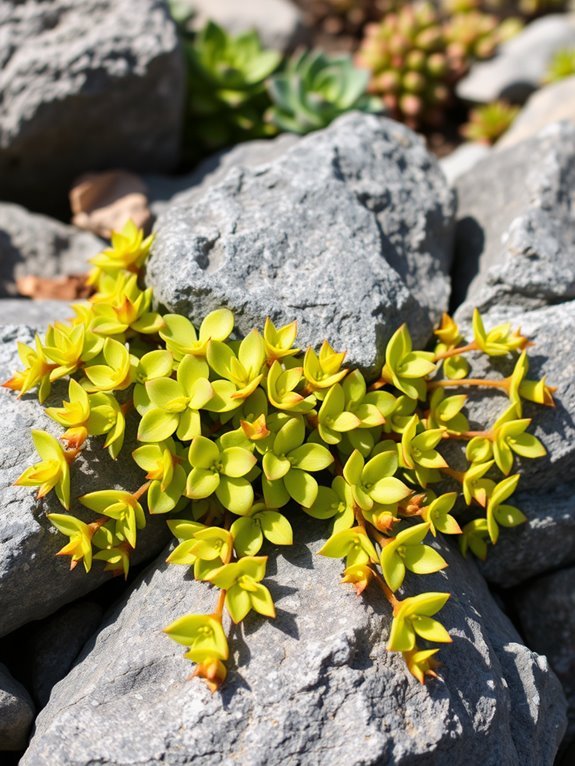
Get ready to be charmed by Sedum ‘Angelina’, a succulent that’s as vibrant as it’s versatile! With its stunning golden-yellow foliage, this plant can brighten any rock garden.
You’ll love how it thrives in poor soil and requires little water—perfect for those who forget to water! Sedum ‘Angelina’ also attracts butterflies, adding a delightful touch to your space.
Plus, it spreads beautifully, creating a lovely ground cover over time. Just remember, it loves the sun, so give it a cozy spot to bask.
With Sedum ‘Angelina’, your garden will be the envy of the neighborhood—no pressure, right?
Sempervivum ‘Pacific Blue Ice’

Meet Sempervivum ‘Pacific Blue Ice’, a stunning succulent that’s bound to steal the show in your rock garden!
With its striking blue-green rosettes and frosty tips, this hardy plant adds a cool vibe to any landscape. You’ll love how it thrives in full sun and poor soil, making it a low-maintenance superstar.
Plus, it produces charming little offsets, so you’ll have even more of these beauties to enjoy!
Just remember, while it’s tough, it doesn’t like sitting in water—so give it some breathing room.
Add ‘Pacific Blue Ice’ to your garden, and watch it shine like a true star!
Graptopetalum Paraguayense
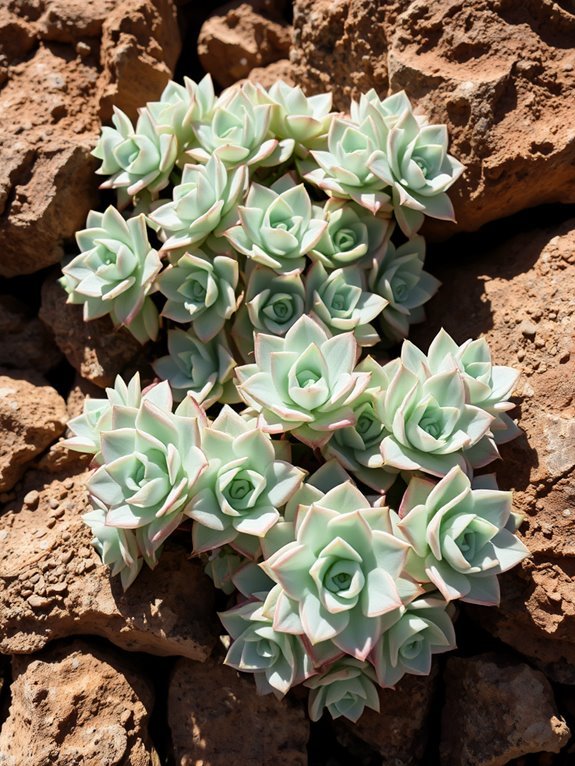
Graptopetalum paraguayense, often called “Ghost Plant,” is a delightful addition to any rock garden, bringing a soft, ethereal charm that perfectly complements the bold presence of Sempervivum ‘Pacific Blue Ice’.
This succulent boasts plump, silvery-blue leaves that form a stunning rosette shape, making it a real showstopper. You’ll love how it thrives in sunny spots, requiring minimal care—talk about low maintenance!
Just be careful not to overwater; it prefers to be a bit dry. With its unique ghostly appearance, you’ll feel like you’ve added a touch of magic to your garden. Who wouldn’t want that?
Aeonium ‘Zwartkop’

If you’re looking to add a dramatic flair to your rock garden, you’ll absolutely love Aeonium ‘Zwartkop.’ Known for its stunning dark, almost black rosettes, this succulent is like the rock star of the plant world.
To make the most of it, keep these tips in mind:
- Sunlight: Make sure it gets plenty of bright, indirect light.
- Soil: Use well-draining soil to prevent root rot.
- Watering: Water sparingly; let the soil dry between drinks.
- Temperature: Protect it from frost, as it’s not a fan of cold.
With ‘Zwartkop’ around, your garden will truly shine!
Crassula Ovata (Jade Plant)

While Aeonium ‘Zwartkop’ brings a touch of drama to your rock garden, Crassula ovata, commonly known as the Jade Plant, adds a charming and friendly vibe.
These succulent beauties are easy to care for, thriving in bright light and needing minimal water. With their glossy, round leaves that resemble little green coins, they’re said to bring good luck—who doesn’t want that?
Plus, they can grow into stunning bushes, becoming a focal point in your garden. Just be careful not to overwater them, or they might start feeling a bit too soggy!
Happy gardening with your new lucky charm!
Haworthia Fasciata

Haworthia fasciata, often called the Zebra Plant, is like the quirky friend of the succulent world, with its striking white-striped leaves that create a fun, eye-catching pattern.
You’ll love how easy it’s to care for this little gem! Here are a few tips to keep it happy:
- Place it in bright, indirect sunlight.
- Water sparingly, allowing the soil to dry out between drinks.
- Use well-draining soil to prevent root rot.
- Keep it in a warm environment, avoiding frost.
With its unique look and low maintenance, Haworthia fasciata is sure to bring joy to your rock garden!
Sedum ‘Dragon’s Blood’
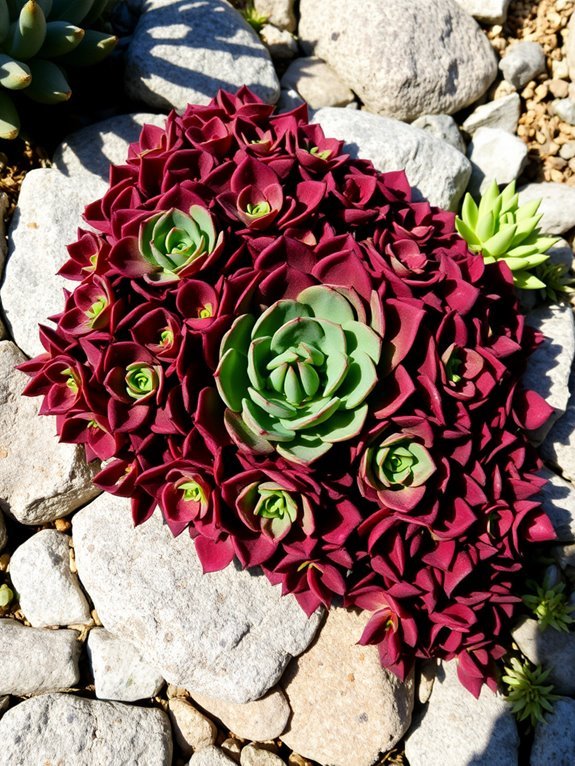
Get ready to meet Sedum ‘Dragon’s Blood’, the fiery star of any rock garden! This charming succulent boasts vibrant red foliage that deepens in color as summer heat sets in.
You’ll love how it effortlessly spills over rocks, creating a stunning, cascading effect. Plus, it’s a breeze to care for! Just give it well-drained soil and a sunny spot, and you’re golden.
In late spring, it surprises you with clusters of bright pink flowers, attracting pollinators like bees and butterflies. Just imagine your garden buzzing with life!
Sedum ‘Dragon’s Blood’ is your ticket to a colorful, low-maintenance paradise!
Agave ‘Blue Glow’

Say hello to Agave ‘Blue Glow’, the cool kid of the succulent world! This striking plant stands out with its vibrant blue-green leaves and charming orange edges.
If you’re considering adding it to your rock garden, here’s why you’ll love it:
- Low maintenance – Just a little sun and water, and it’s happy!
- Drought-tolerant – It thrives in dry conditions, saving you effort.
- Unique look – Its architectural form draws the eye, making it a showstopper.
- Perfect for containers – Agave ‘Blue Glow’ fits beautifully in pots, too!
Get ready to impress your gardening friends!
Delosperma Cooperi (Ice Plant)

If you thought Agave ‘Blue Glow’ was the only star of your rock garden, think again!
Meet Delosperma cooperi, better known as the Ice Plant. This vibrant succulent brings a burst of color with its stunning, daisy-like flowers that bloom in late spring.
You’ll love how it thrives in sunny spots, requiring little water—perfect for those lazy summer days!
Plus, it creates a lush mat of foliage, which helps prevent weeds from crashing the party.
Just imagine the cheerful yellow and pink blooms dazzling alongside your Agave.
Trust me, your rock garden deserves this showstopper!
Kalanchoe Tomentosa (Panda Plant)

Kalanchoe tomentosa, or the charming Panda Plant, is a delightful addition to any rock garden that’s sure to steal your heart!
With its fuzzy, gray-green leaves and cute, panda-like ears, it adds a playful touch to your landscape.
Here’s why you’ll love it:
- Low maintenance: Just a little watering and it’s happy!
- Unique texture: Its fuzzy leaves bring visual interest.
- Fun blooms: Watch for adorable yellow flowers in the right conditions.
- Versatile: Perfect for pots, borders, or mixed succulent arrangements.
Echeveria ‘Perle Von Nürnberg’

Moving from the delightful charm of Kalanchoe tomentosa, let’s turn our attention to another enchanting succulent: Echeveria ‘Perle Von Nürnberg’.
This beauty boasts lovely, dusty lavender leaves that form a rosette, making it a standout in any rock garden. You’ll adore how its colors shift with sunlight, creating a mesmerizing display.
Plus, it’s easy to care for! Just give it well-draining soil and bright light, and watch it thrive. It’s like having a little piece of art in your garden.
Lithops (Living Stones)

When you think about unique and quirky plants to add to your rock garden, Lithops, or Living Stones, might just steal your heart.
These fascinating succulents resemble tiny stones, blending seamlessly into your landscape. Plus, they’re low-maintenance and drought-tolerant!
Here’s why you’ll love them:
- Variety: They come in numerous shapes and colors.
- Minimal Water: Just a sip here and there keeps them happy.
- Fun to Collect: Each one’s like a little treasure.
- Conversation Starters: Friends will be amazed by your “rock” collection!
Add some Lithops, and watch your garden come alive!
Senecio Mandraliscae (Blue Chalksticks)

If you’re looking to add a splash of color to your rock garden, Senecio Mandraliscae, commonly known as Blue Chalksticks, is a fantastic choice!
These charming succulents boast striking blue-green leaves that resemble little chalk sticks, hence their name. They thrive in well-draining soil and love the sun, so place them where they’ll soak up those rays.
Plus, they’re drought-tolerant, making them perfect for busy gardeners. Just be careful not to overwater them—nobody likes soggy roots!
With their unique look and easy care, Blue Chalksticks will have your rock garden shining brighter than a summer day!
Dudleya Brittonii
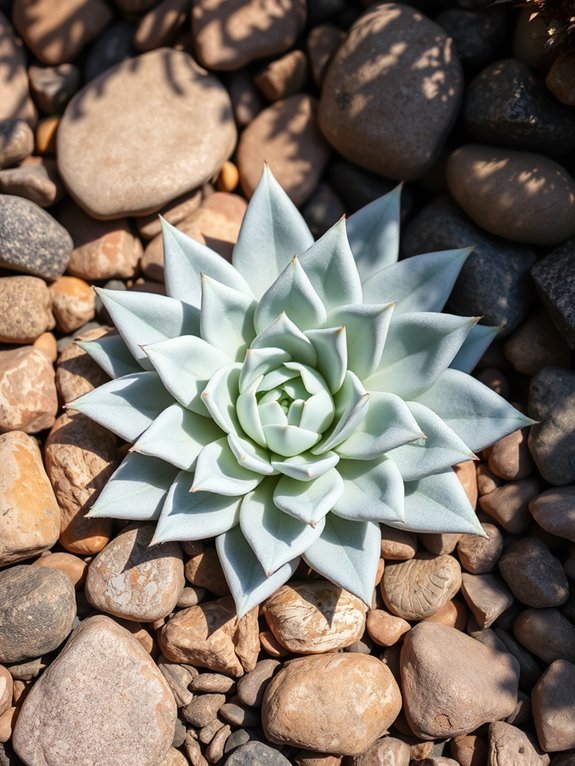
Dudleya Brittonii, also known as the Britton’s Dudleya or the California Liveforever, is a standout star in the succulent world, and it’s easy to see why!
This charming plant not only adds beauty to your rock garden, but it’s also low-maintenance.
Here’s why you’ll love it:
- Unique Appearance: Its fleshy, gray-green leaves form stunning rosettes.
- Drought Tolerant: Perfect for those “I forgot to water” days!
- Pollinator Friendly: Attracts bees and butterflies, adding life to your garden.
- Versatile: Thrives in various conditions, whether in sun or partial shade.
Get ready to enjoy this beauty!
Faucaria Tigrina (Tiger Jaws)

Faucaria Tigrina, affectionately known as Tiger Jaws, is a delightful addition to any rock garden, and it’s sure to capture your heart!
The thick, fleshy leaves boast unique, jagged edges that resemble a tiger’s jaw—how cool is that? When it blooms, you’ll be treated to charming yellow flowers that dance in the sun.
This succulent thrives in well-drained soil and loves bright light, so it’ll fit right in among your rocks.
Just remember, it doesn’t want to be too wet, or it might sulk.
Add Tiger Jaws to your garden, and watch it become the center of attention!
Portulacaria Afra (Elephant Bush)

After admiring the striking Tiger Jaws, you might find yourself drawn to another enchanting succulent: Portulacaria Afra, commonly known as Elephant Bush.
This quirky plant’s thick, rounded leaves resemble tiny, green coins, making it a fun addition to any rock garden. Plus, it’s super easy to care for!
Here are a few reasons you’ll love it:
- Tolerates drought like a champ.
- Grows well in various light conditions.
- Attracts butterflies and bees—what’s not to love?
- Can even be pruned into a cute bonsai shape!
Aloe Vera
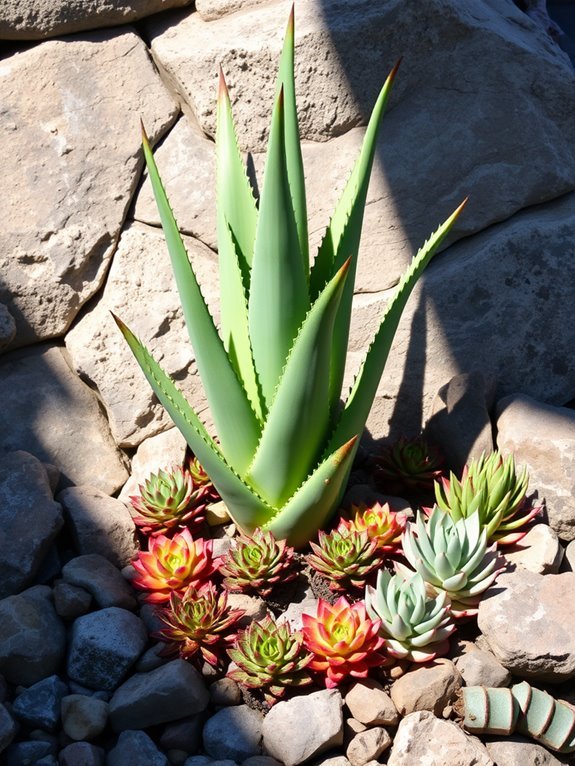
If you’re looking to add a touch of green magic to your rock garden, Aloe Vera is definitely a plant you don’t want to miss!
This versatile succulent not only thrives in rocky nooks but also brings a revitalizing vibe. With its thick, fleshy leaves, Aloe Vera looks stunning against those rugged stones. Plus, it’s got that fabulous reputation for healing sunburns—nature’s little band-aid!
Just remember, it loves sunny spots and can handle some neglect. So, whether you’re a plant expert or just starting, Aloe Vera is an easy and charming addition that’ll make your rock garden shine.
Who doesn’t love a multitasker?
Rhipsalis Baccifera (Mistletoe Cactus)

When you think about adding something unique to your rock garden, Rhipsalis Baccifera, also known as the Mistletoe Cactus, should definitely come to mind!
This quirky plant boasts long, trailing stems that can create a stunning visual effect. Plus, it’s low maintenance!
Here are four reasons to contemplate it:
- Adaptability: It thrives in various light conditions.
- Air Purifier: It helps improve indoor air quality.
- Blooms: You might be surprised by its delicate flowers!
- Unique Look: Its unusual shape adds character to your display.
Trust me, your rock garden will thank you!
Senecio Rowleyanus (String of Pearls)

One look at Senecio Rowleyanus, affectionately known as the String of Pearls, and you’ll see why it’s a rock garden favorite!
With its charming, bead-like leaves cascading down like nature’s own jewelry, this succulent adds a delightful touch to any display.
You’ll love how it thrives in bright light, requiring minimal care—perfect for those of us who might forget to water occasionally!
Just don’t let it sit in soggy soil; it prefers to dry out between drinks.
Plus, it’s a conversation starter! Imagine your friends’ faces when they see this unique beauty twinkling in your garden.
Frequently Asked Questions
How Do I Propagate Succulent Plants Effectively?
To propagate succulent plants effectively, you can take leaf cuttings or offsets. Let them dry for a day to callous, then plant in well-draining soil. Water sparingly until roots establish, and watch them thrive!
What Soil Is Best for Growing Succulents?
What’s the secret to thriving succulents? You need well-draining soil, ideally a mix of potting soil, sand, and perlite. This combination guarantees your plants get enough moisture without drowning, promoting healthy growth and vibrant colors.
Can Succulents Survive in Colder Climates?
Yes, succulents can survive in colder climates, but you’ll need to choose hardier varieties. Providing proper insulation and protection during freezing temperatures helps them thrive, ensuring they stay healthy and vibrant through winter months.
How Often Should I Water My Succulents?
You should water your succulents every two to three weeks, letting the soil dry out completely between waterings. Adjust the frequency based on your climate and the season, but don’t overwater them!
What Pests Commonly Affect Succulent Plants?
You’ll often find pests like mealybugs, aphids, and spider mites affecting your succulents. Keep an eye out for sticky residue or webbing, and treat infestations promptly to protect your plants and guarantee their health.
Conclusion
Transform your garden into a vibrant oasis with stunning succulents. Imagine a dazzling display of Echeveria ‘Lola’, Sedum ‘Dragon’s Blood’, and quirky Lithops peeking out from the stones.
With just a little love and sunshine, these succulent stars will thrive. They will bring a splash of color and fun to your outdoor space, making your rock garden the talk of the neighborhood.
Who wouldn’t want to showcase their succulent masterpieces? Let’s dig in and get planting!





